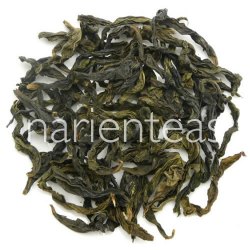- Brewing & Distilling
- Caffeine Free
- Culinary
- Fair Trade
- Medicinal
- Organic
- Sprouting Seeds
- Tisane
- Viable Seeds
- Wildcrafted
Free Shipping $49+
December Discount 10%
Oolong Tea
Oolong tea is an amazingly diverse class of tea. It can provide flavors as fresh and vibrant as a green tea or as bold and invigorating as a black tea.
Oolong is known as a "semi-oxidized" tea. The process can be allowed to progress anywhere from 10-80% (although most oolongs are 25-80% oxidized). Pouchong, like our Formosa Pouchong, is the most lightly oxidized and is more reminiscent of green teas. Most other Formosa oolongs are on the more heavily oxidized end of the spectrum.
Oolong is made from large tea leaves and it is among the most complicated to make. The final form might be long and twisted or rolled into irregular ball shapes.
It is thought that oolongs were developed in China as a way to cope with tea plants that were producing lackluster green teas. Many years of experimentation resulted in the techniques that allowed oxidation to be stopped at a variety of stages.
Chinese and Taiwanese oolongs are certainly the most revered. These are the homes of the original oolongs. Light oolongs contain floral notes like lilac, gardenia, and jasmine. Darker (more heavily oxidized) oolongs have stone fruit aromatics. Oolongs generally have very long finishes and some sweetness.
Oolong Tea Production

Plucking
Oolongs intended for this shape are plucked as the bud plus two to three leaves connected by a stem.Sorting and Cleaning
Twigs, stems, and rocks are removed and the leaves are separated by size.Withering and Oxidation
The leaves are withered in the sun, turning to keep them heating evenly. The leaves are cooled and then rolled. The process can take up to 9 hours with the leaves being rolled for a few minutes, then left for a couple of hours. Oxidation takes place during this time.Heating and Rolling
The leaves are heated to stop oxidation. They are then shaped by hand or machine into balls or half-balls. The tea is then dried or baked for a few minutes at a time over an 8 hour span, before a final cooling.For oolong teas intended for a finished shape of a slight twist, such as our Formosa:
Plucking
A single large leaf is selected.
Sorting and Cleaning
Twigs, stems, and rocks are removed and the leaves are separated by size.
Withering
The leaves are withered in the sun, turning to keep them heating evenly.
Oxidation
The leaves are cooled and flattened, then shaken and tossed for short periods over a six hour period. This tossing bruises the leaves, causing oxidation. The leaves are then heated to halt oxidation.
Drying, Finishing, and Firing
The leaves are given a final drying and firing to remove the remaining excess moisture content.

Brewing Oolong Tea
Oolong tea generally steeps at 180-212 degrees Fahrenheit. The more lightly oxidized oolongs should steep at cooler temperatures while heavily oxidized oolongs can steep hotter. These teas should generally be steeped for 2-4 minutes using 2-3 grams (1 tsp) of leaf per 6 ounces.Lighter oolongs have pale green yellow liquors while dark oolongs may have more orange coloration in their brew.
Oolongs can often steep 8 - 9 times. If you intend to steep repeatedly, try using more leaf and brew for 1 minute for the first cup. Add 5 seconds of time for each new steep.
Caffeine in Oolong Tea
The caffeine content of teas depends upon many factors: the cultivar of the tea plant, the age of the leaf being picked, and where on the stem the leaf is located, how long it is oxidized, leaf size, how much leaf is used, the temperature of brewing, and how long the tea steeps.
Studies have shown that one pound of tea leaves has more caffeine than one pound of coffee. However, it takes less tea than coffee to brew a cup. Therefore, there is actually 50-65% less caffeine in a cup of tea than in a cup of coffee. Plus, the way the caffeine is absorbed is different. With tea, the caffeine is absorbed more gradually so you tend not to get the big caffeine burst nor the caffeine crash.
Oolongs with a single twist likely contain less caffeine than ball-shape oolongs which contain buds and younger leaves. More lightly oxidized oolongs also tend to have less caffeine than dark oolongs or black teas because they are steeped at a lower temperature for shorter periods of time.
